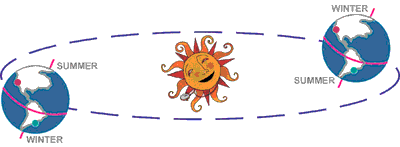| June 3, 1999 |
|
Previous Next |
||
|
|
||||
|
| ||||
People have always been interested in understanding the Sun’s relation to the Earth. The length of the day has important effects on our weather, our seasons, our harvests, and on how we think about the world around us. Throughout history, there have been two main models to explain the seasonal changes and the length of the day: heliocentric (with the Sun/Helios in the center of the plan etary system) and geocentric (with the Earth/Geos at the center). | ||||

The illustration on the left shows a famous geocentric model proposed by Ptolemy over 1800 years ago. In this case, the length of the day changes over the course of a year because while the Earth is in the middle, it is slightly off center, and the Sun changes its speed as it moves around the Earth. (The seasons are shown for just the Northern Hemisphere.) | ||||
The illustration below shows the heliocentric model as proposed by Copernicus in the 1540's. In this model, the change in day length is related to the tilt of the Earth as it moves around the Sun. When the Northern Hemisphere is tilting towards the Sun, the day is long and we have summer. Note that when Los Angeles is tilted towards the Sun, locations in the Southern Hemisphere (such as in Brazil) are titled away from the Sun, so the length of the day there is shorter. In each case, the change in day length results from a change in the angle of the Earth in relation to the Sun. | ||||

| ||||
What I would like you to do for next week is to tell me how YOU would decide which model is correct. What experiment would you do to figure out whether the S un goes around the Earth, or the Earth goes around the Sun? Can you tell the di fference from measuring the movement of the Sun alone? If the Earth is actually moving around the Sun (as most people now believe), why is it that the Sun (and not the Earth) appears to be moving across the sky? Next week we will publish your answers to these questions, so send them in or post your answers at the bulletin boards at the Sun Spot! | ||||
Oops! Last week I goofed. If you can find my mistake, enter it at the Data Machine at the Sun Spot to claim your reward! | ||||
| Whyville Square | Introduction | Series 1: Spinning | enter>Series 2: About Time | Times Building Entrance | Log Out |